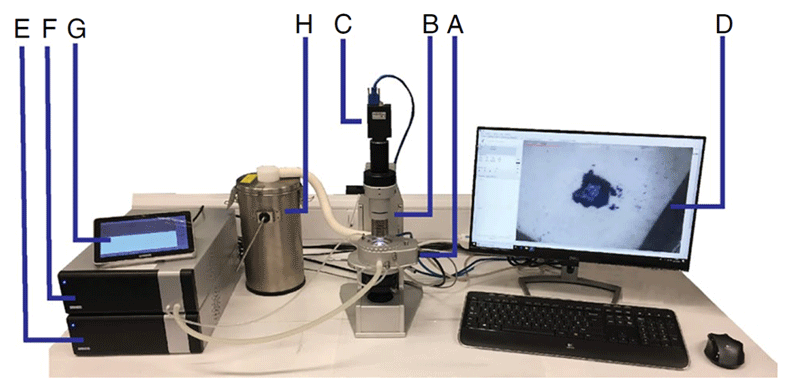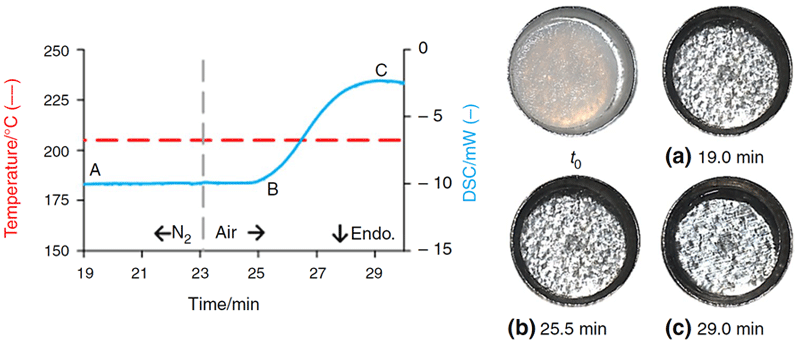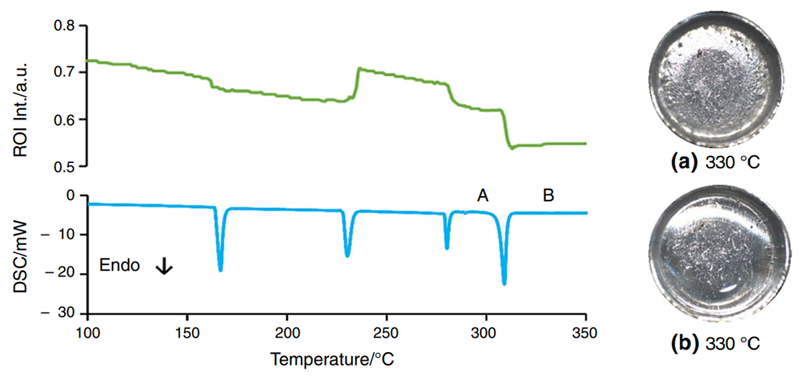Simultaneous thermal analysis
Dr Gareth Parkes at the University of Huddersfield, UK, and Duncan Stacey at Linkam Scientific Instruments, UK, combine differential scanning calorimetry with thermomicroscopy to analyse energy changes and optical features of materials.

b) Linkam imaging station (a stereoscopic microscope), c) high-resolution digital camera, d) PC running LINK, e) controller unit, f) liquid nitrogen pumping unit, g) touchscreen control and h) liquid nitrogen reservoir © Ashton, G.P., Charsley E.L., Harding, L.P., and Parkes, G.M.B. Applications of a simultaneous differential scanning calorimetry — thermomicroscopy system. Journal of Thermal Analysis and Calorimetry, 2022; 147: 1345-1353
Understanding the way materials behave under different conditions is integral to optimising their use in almost all applications, from industrial polymers to pharmaceutical research and development. Thermal analysis methods such as thermomicroscopy allow researchers to observe optical and physical transitions as a material progresses through a reaction. By integrating other techniques, such as differential scanning calorimetry (DSC), energy changes (enthalpy) can also be measured.
DSC is one of the most widely used thermal analysis techniques to measure the temperature and heat flow associated with thermal transitions in materials. Although it can be used to measure almost any reaction that takes place with a change in energy, DSC is non-specific. It must therefore be coupled with other methods, such as thermomicroscopy, to enable the direct observation of phase changes, like solid-solid transitions, as well as fusion reactions and decomposition.
Despite the clear advantages of combining DSC and thermomicroscopy, and the availability of systems that integrate the two methods, there has been surprisingly little research published using simultaneous DSC-thermomicroscopy to analyse various materials. The improving quality of digital microscopes and growing computing power available to labs is likely to contribute to greater interest in this technology in the coming years.
Researchers at the Thermal Methods Research Unit (TMRU) at the University of Huddersfield, UK, led by Dr Gareth Parkes, have investigated the use of a heat flux DSC plate incorporated into a hot stage to allow DSC-thermomicroscopy measurements on the same sample, simultaneously. In this article, we explore the benefits of this technology in obtaining information about the optical and enthalpic properties of a broad range of materials – chosen based on the fact that they show optical transitions and/or energy changes and cover a broad range of systems.
Novel thermal system
For the present study, a recently introduced DSC-thermomicroscopy system was used to study phase transitions in rubidium nitrate and the oxidation of polyethylene. This is the first time that these materials have been analysed using DSC and thermomicroscopy on the same instrument.
The Optical DSC450 System comprises a heat flux DSC plate incorporated into a hot stage, a T96-S temperature controller unit and LINK software (shown in the image above). The system operates over a -150 to 450°C temperature range. Thermomicroscopy imaging was obtained through a high-resolution digital camera coupled to a stereoscopic microscope.
Thermal stability of polymers
Polyethylene
To better understand the oxidative degradation of polymeric materials and its impact on stability at elevated temperatures, the TMRU group conducted oxidative induction time (OIT) experiments on ultra-high molecular weight polyethylene (UHMWPE). The Optical DSC450 System was used to control the sample temperature between 30-205°C, and the OIT effect was analysed under an inert nitrogen atmosphere, which was then switched to dry air during the isothermal period.
The melting of the UHMWPE was observed at onset temperature Tonset 109.9°C (shown in the figure below, left), and the DSC profile indicated the onset of the exothermic oxidation. Using thermomicoscopy at the same time, the optical micrographs enable these processes to be observed optically and correlated with the DSC profile. The researchers could visualise the change in surface texture of the liquid polymer after melting as oxidative degradation began.
The OIT test shows the expected DSC profile, but additional information on the subtle changes in surface morphology that occur at the onset of oxidation are revealed optically.

© Ashton, G.P., Charsley E.L., Harding, L.P., and Parkes, G.M.B. Applications of a simultaneous differential scanning calorimetry — thermomicroscopy system. Journal of Thermal Analysis and Calorimetry, 2022; 147: 1345-1353

Visualising phase transitions
Rubidium nitrate
Materials showing multiple polymorphic transitions are often useful temperature calibration standards given their ability to cover a wide temperature range. In this study, the group evaluated the polymorphic transitions of rubidium nitrate, a material with three distinct solid-state transitions over a 150-280°C temperature range. The DSC profile shows three peaks corresponding to the solid-solid transitions, with the final peak corresponding to the sample melting (shown in the figure above, left). The corresponding region of interest (ROI) profile from thermomicroscopy shows the same transitions as a series of steps caused by changes in the sample’s reflected light intensity (RLI).
These results demonstrate the benefit of using RLI from thermomicroscopy together with DSC when discerning phase transitions, when the sample remains colourless. The group at TMRU has also investigated low-temperature calibration standards using the DSC450, elucidating the effect of temperature cycling on materials.
Future applications
The experiments in this study demonstrate the complementary nature of DSC and thermomicroscopy, and the benefits of simultaneous thermal analysis in unravelling the complex thermal processes of certain materials. DSC-thermomicroscopy can provide enhanced information in the study of materials, because the optical image facilitates the interpretation of often complex and overlapping DSC profiles. The technique is expected to become increasingly popular in the polymer and pharmaceutical sectors.
The research group at the TMRU is currently exploring whether the unique design of the DSC450 will lend itself to the study of thermal conductivity of materials via optical means.

